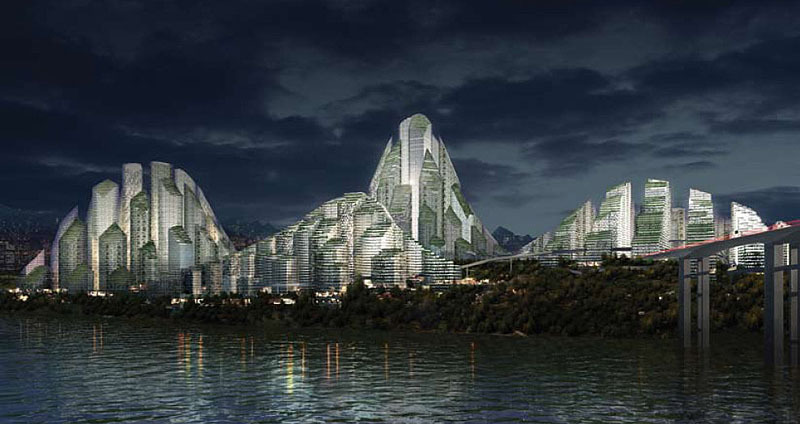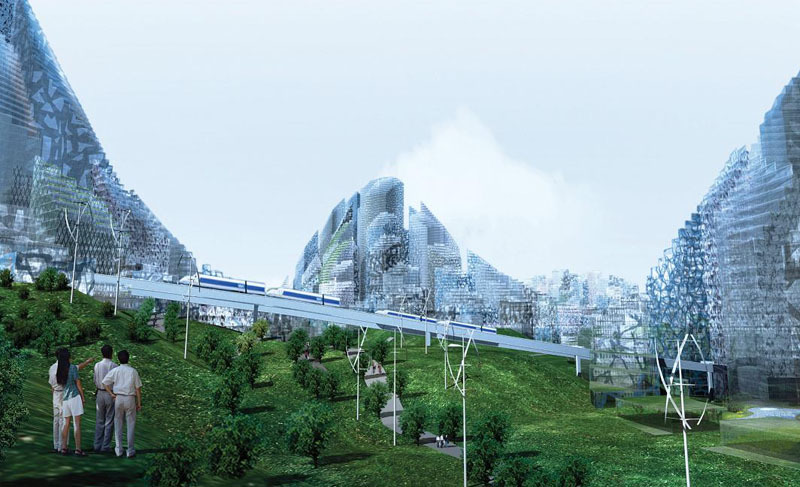When I went to the Biennale of Architecture in Venice in 2006, the theme for that year was Cities, Architecture and Society. The Danish pavilion won the Golden Lion (Best National Participation) for 4 different designs for new cities in China done in collaboration with Chinese students of architecture.
I was surprised to see that in many ways these 4 designs were not very different from the visionary ideas of Corbusier or the very concrete suburbs where the grand plans have led to widespread “Social China Syndromes.” The major difference from earlier plans was that now the focus was on public transport and not the car. But it was based on the same type of rational planning that ignores that a city needs a soul to grow from – just as it needs the necessary infrastructure etc.
The whole biennale was focused on this particular type of sustainability: how to save energy, create less sprawl, save the rainforest and the last green frog but there was a spectacular lack of social and political aspects in this effort to save the planet. In other words could these sustainable cities be build in an undemocratic society that would violate human rights, freedom of speech, inhuman working conditions or where thousands were forced to leave their homes in order for new cities to be build just to name a few unsustainable social aspects?
The 4 Danish winner projects all used the same check list for sustainability called the Equator Principles, “a voluntary set of standards for determining, assessing and managing social and environmental risk in project financing (….) which have become the de facto standard for banks and investors on how to assess major development projects around the world” according to Wikipedia. Why the curator of the 4 projects chose a checklist made by the big banks is not clear, but these principles do deal with a mix of social and environmental issues and they could be a guarantee against the above mentioned focus on only the rational and physical aspects of the city.
Already being annoyed by the biennales take on the “sustainable” city I couldn’t help being amused by some of the rather helpless answers on the checklist such as:
a) Assessment of the baseline social and environmental conditions?
The Jiading region as such is a fairly well-functioning part of Shanghai, with a brand new F1 track and a planned eco-park at a nearby site. In the midst of becoming the number one cluster for the car industry in China, the region is booming with optimism and the gradual urbanization of the region will distribute social and economic welfare from the inner city to the fringes.
i) Socioeconomic impacts?
Due to the special qualities of the area and the high quality architectural design more investments will be attracted to Chongqing, which is believed to have a positive knock-on effect on the community within as well as outside of the site.
n) Consultation and participation of affected parties in the design, review and implementation of the project?
Not applicable.
One can sense the (perfectly designed) echo chamber where architects sit together padding each others back talking about how architecture itself will one day save the world – a world booming with optimism by the way. If there is any problems it is the sprawl and the car. Everything else is OK.
So far it still felt a bit naive and the text might not really be that important since the illustrations were quite striking in their beauty. Yet I started looking into the “real” Equator Principles and found out that the checklist used in the 4 projects was an edited version of the original where several of the more political issues were left out or watered down such as “human rights” that became “human health”
This is three issues on the Equator Principles list:
d) protection of human rights and community health, safety and security (including risks, impacts and management of project’s use of security personnel)
e) protection of cultural property and heritage
f) protection and conservation of biodiversity, including endangered species and sensitive ecosystems in modified, natural and critical habitats, and identification of legally protected areas
This is how it was boiled down in the Biennale text:
Protection of human health, cultural properties, and biodiversity, including endangered species and sensitive ecosystems?
The list used in the Biennale projects were taken from a Wikipedia article on the Equator Principles that apparently had been “edited”. What it does reflect is a rather sloppy way of handling a potentially hot political potato. One wonders if this sudden interest in saving the Chinese people from the awful consequences of SPRAWL. Could it be, that it is much easier to work on grand designs similar to those Corbusier was dreaming of in a society where they are more concerned with “human health” than “human rights”.

